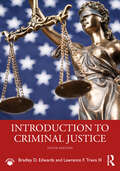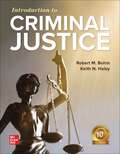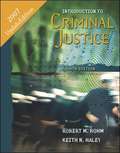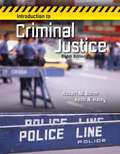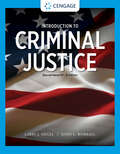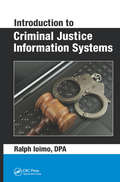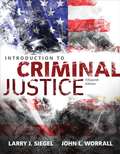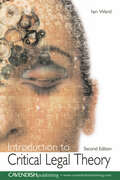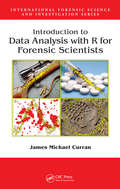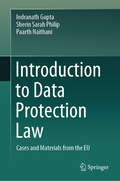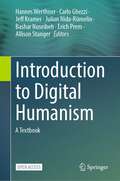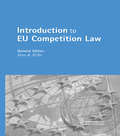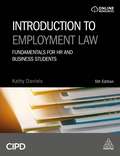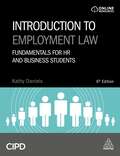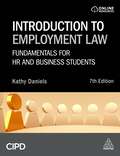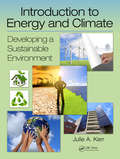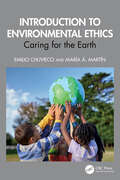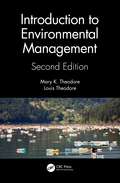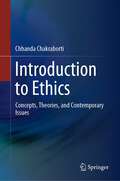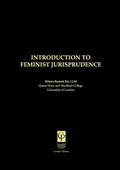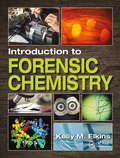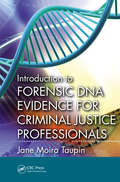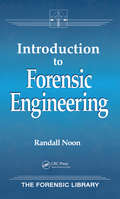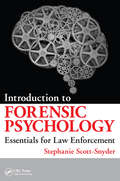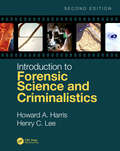- Table View
- List View
Introduction to Criminal Justice
by Bradley D. Edwards Lawrence F. Travis IIIIntroduction to Criminal Justice, Tenth Edition, offers a student-friendly description of the criminal justice process—outlining the decisions, practices, people, and issues involved. It provides a solid introduction to the mechanisms of the criminal justice system, with balanced coverage of the issues presented by each facet of the process, including a thorough review of practices and controversies in law enforcement, the criminal courts, and corrections.In this revision, Edwards updates the statistics and research findings throughout. New sections include the impact of the COVID-19 pandemic, the recent shift to NIBRS crime reporting, and the increasing attacks on the legitimacy of the criminal justice system. This edition has also expanded coverage of police use of force and technological improvements. Selected chapters now include a case study box to demonstrate how certain laws, programs, and technologies have been used in particular situations.Appropriate for all U.S. criminal justice programs, this text offers great value for students and instructors.
Introduction to Criminal Justice
by Robert Bohm.Keith HaleyIntroduction to Criminal Justice, 10e, provides a comprehensive study of the criminal justice system. A detailed analysis of the major components of the criminal justice system: law enforcement, the administration of justice, and corrections are provided throughout this new edition. New topics and statistics have been added thereby keeping the students more engaged with the material. An entire chapter is devoted to the juvenile justice system. Experts on the subject with nearly 100 years of experience between them as both practitioners and teachers, authors Robert Bohm and Keith Haley present criminal justice students with an engaging narrative that encourages them to think critically about the subject.
Introduction to Criminal Justice (4th Edition Update)
by Robert M. Bohm Keith N. HaleyIntroduction to Criminal Justice, Fourth Edition update is not just for students interested in pursuing a career in criminal justice. It is also for students who simply want to learn more about this important social institution, which is vital to a free and democratic society. All citizens need to know their legal rights and responsibilities.
Introduction to Criminal Justice (Eighth Edition)
by Robert Bohm Keith HaleyIntroduction to Criminal Justice is the perfect text for students who are interested in pursuing a career in criminal justice and for those who simply want to learn more about the criminal justice system. The authors' combined experience of more than 50 years in teaching introduction to criminal justice as well as working in the field -- Bohm as a correctional officer and Haley as a police officer -- come through in their accessible yet comprehensive presentation. They make it easy for readers to understand that much of what the public "knows" about criminal justice in the United States is myth, and help students learn the truth about the U. S. criminal justice system. With the CourseSmart eTextbook version of this title, students can save up to 50% off the cost of a print book, reduce their impact on the environment, and access powerful web tools for learning. Faculty can also review and compare the full text online without having to wait for a print desk copy. CourseSmart is an online eTextbook, which means users need to be connected to the internet in order to access. Students can also print sections of the book for maximum portability.
Introduction to Criminal Justice (Mindtap Course List Series)
by Larry J. Siegel John L. WorrallTake a close look at the intriguing concepts, policies and processes at work in today's criminal justice system with Siegel/Worrall's best-selling INTRODUCTION TO CRIMINAL JUSTICE, 17E. Known for trusted, solidly researched content, this reader-friendly presentation examines the impact of recent events, such as the coronavirus pandemic, racial unrest and publicized shootings, on contemporary crime and the criminal justice system. <p><p>This edition is packed with provocative, high-profile examples and the latest developments and trends—from new crime-countering technology to efforts in criminal justice reform. Inviting narratives, vivid illustrations, fascinating cases and special topic features delve into the intricate workings behind policing, courts and correctional systems. You examine issues such as stereotyping, recent scandals and the implications of court decisions and career options as you gain a better understanding of the challenges and opportunities within criminal justice.
Introduction to Criminal Justice Information Systems
by Ralph IoimoThe proliferation of information systems throughout the criminal justice system has prompted many universities supporting criminal justice programs to add criminal justice information systems technology to their curriculums. Several universities have gone so far as to hire professors with specializations in information technology and to offer criminal justice information systems as an area of concentration. Introduction to Criminal Justice Information Systems gives an overview of the various software systems and technologies currently used in the criminal justice environment. The book covers a variety of topics critical to each member of the criminal justice system: police, prosecutor, courts, and corrections. It details the current systems in use, how they are used, and how separate systems interact with others. It also suggests how the current technology and the processes built upon it will evolve. While designed as a textbook to meet the needs of an introductory criminal justice information technology course, Introduction to Criminal Justice Information Systems is also a flexible resource useful to professionals in relevant areas of the criminal justice system. With rapidly increasing development and use of technology in modern law enforcement, this book provides a much-needed reference for those who are responsible for its implementation as well as an essential introduction to those who will become responsible for it. An instructor's manual is available as an electronic download upon request.
Introduction to Criminal Justice, Fifteenth Edition
by Larry J. Siegel John L. WorrallINTRODUCTION TO CRIMINAL JUSTICE, Fifteenth Edition, gives readers an exciting behind-the-scenes look at the workings of the police, courts, and correctional systems while equipping them with a solid understanding of criminal justice concepts. With its objective presentation and to-the-point writing style, the text effectively guides readers through the intricate workings of the processes of justice as well as key policy issues. The book also includes an emphasis on today's criminal justice careers, offering insights from numerous professionals on the rewards and realities of their jobs.
Introduction to Critical Legal Theory
by Ian WardIntroduction to Critical Legal Theory provides an accessible introduction to the study of law and legal theory. It covers all the seminal movements in classical, modern and postmodern legal thought, engaging the reader with the ideas of jurists as diverse as Aristotle, Hobbes and Kant, Marx, Foucault and Dworkin. At the same time, it impresses the interdisciplinary nature of critical legal thought, introducing the reader to the philosophy, the economics and the politics of law. This new edition focuses even more intently upon the narrative aspect of critical legal thinking and the re-emergence of a distinctive legal humanism, as well as the various related challenges posed by our 'new' world order. Introduction to Critical Theory is a comprehensive text for both students and teachers of legal theory, jurisprudence and related subjects.
Introduction to Data Analysis with R for Forensic Scientists (International Forensic Science and Investigation)
by James Michael CurranStatistical methods provide a logical, coherent framework in which data from experimental science can be analyzed. However, many researchers lack the statistical skills or resources that would allow them to explore their data to its full potential. Introduction to Data Analysis with R for Forensic Sciences minimizes theory and mathematics and focus
Introduction to Data Protection Law: Cases and Materials from the EU
by Indranath Gupta Sherin Sarah Philip Paarth NaithaniThis textbook considers cases and materials introducing European Union (EU) data protection law to data protection enthusiasts while acting as a reference point for students and practitioners. The book's utility is twofold: the cases and materials can be used as a textbook as well as reference point for research. The book will benefit individuals new to this area and those at an intermediate level of familiarity with data protection law. It includes judgements delivered by the Court of Justice of the European Union (CJEU)/ European Court of Justice (ECJ) and decisions delivered by Data Protection Authorities (DPA) in the EU. While providing an overview of data protection law in the EU, the book introduces basic concepts of data protection law, principles of data protection law and rights and duties and remedies under the data protection law. Students would greatly benefit from the book by using it as an introduction to data protection law and as a reference point for research and assessments. Course instructors would benefit from the book by using it as core reading material.
Introduction to Digital Humanism: A Textbook
by Hannes Werthner Allison Stanger Carlo Ghezzi Jeff Kramer Bashar Nuseibeh Julian Nida-Rümelin Erich PremThis open access textbook introduces and defines digital humanism from a diverse range of disciplines. Following the 2019 Vienna Manifesto, the book calls for a digital humanism that describes, analyzes, and, most importantly, influences the complex interplay of technology and humankind, for a better society and life, fully respecting universal human rights. The book is organized in three parts: Part I “Background” provides the multidisciplinary background needed to understand digital humanism in its philosophical, cultural, technological, historical, social, and economic dimensions. The goal is to present the necessary knowledge upon which an effective interdisciplinary discourse on digital humanism can be founded. Part II “Digital Humanism – a System’s View” focuses on an in-depth presentation and discussion of the main digital humanism concerns arising in current digital systems. The goal of this part is to make readers aware and sensitive to these issues, including e.g. the control and autonomy of AI systems, privacy and security, and the role of governance. Part III “Critical and Societal Issues of Digital Systems” delves into critical societal issues raised by advances of digital technologies. While the public debate in the past has often focused on them separately, especially when they became visible through sensational events the aim here is to shed light on the entire landscape and show their interconnected relationships. This includes issues such as AI and ethics, fairness and bias, privacy and surveillance, platform power and democracy. This textbook is intended for students, teachers, and policy makers interested in digital humanism. It is designed for stand-alone and for complementary courses in computer science, or curricula in science, engineering, humanities and social sciences. Each chapter includes questions for students and an annotated reading list to dive deeper into the associated chapter material. The book aims to provide readers with as wide an exposure as possible to digital advances and their consequences for humanity. It includes constructive ideas and approaches that seek to ensure that our collective digital future is determined through human agency.
Introduction to EU Competition Law
by Peter WillisThis book provides an introductory but thorough guide to EU competition law, covering the underlying economics, and the key substantive areas of anticompetitive agreements (Article 81), abuses of dominance (Article 82), the application to the most common types of commercial agreement, state aids, state measures limiting competition and mergers. It also examines the procedures under which the relevant competition authorities apply the rules, private enforcement of the rules before the courts, and minimising risk by implementing a compliance programme. The emphasis is practical rather than theoretical: the authors are practitioners in the field of competition law and economics, with many years’ individual and collective experience in the area. This will be an essential reference tool for practitioners, academics and students of EU Competition Law.
Introduction to Employment Law: Fundamentals for HR and Business Students
by Kathy DanielsWritten specifically for HR and Business students, Introduction to Employment Law is a clear and accessible guide to employment law and how it applies in practice. Covering everything from employment tribunals and discrimination to redundancy and termination of employment, this textbook doesn't assume any prior knowledge of the UK legal system and equips students with all the knowledge and skills that they need to take forward into the workplace.Fully revised with all the latest cases and legal developments, this new edition includes coverage of hot topics such as defining employment status in the gig economy, gender pay reporting, the General Data Protection Regulation (GDPR) and the legal implications to be considered with Britain's withdrawal from the European Union. Packed with pedagogical features to consolidate learning including chapter objectives, tasks, 'explore further' sections, key learning points and examples to work through, as well as a dedicated study skills chapter, Introduction to Employment Law is essential reading for all students studying the CIPD Level 5 Intermediate module in employment law as well as being a useful resource for those studying at level 3 and an accessible introduction for level 7 and those on undergraduate and postgraduate courses needing a thorough grounding in employment law. Online resources include lecture slides, case studies, multiple choice questions, annotated weblinks and an instructor's manual.
Introduction to Employment Law: Fundamentals for HR and Business Students
by Kathy DanielsWritten specifically for HR and business students, Introduction to Employment Law is a clear, accessible and jargon-free guide to UK employment law and how it applies in practice. This book covers all the essentials of employment law including employment contracts, discrimination, redundancy and employment tribunals. There is also expert guidance on key issues including shared parental leave, flexible working policies and protected characteristics. Fully revised with the latest cases and legal developments, this new edition includes coverage of the rights of agency workers, bereavement leave, furlough practices and the legal implications of Brexit. This textbook doesn't assume any prior knowledge of the UK legal system and equips students with the knowledge and skills that they need to take forward into the workplace. Packed with pedagogical features to consolidate learning including tasks, examples, explore further sections and key learning points as well as a dedicated study skills chapter covering employment law assignments and exams, Introduction to Employment Law is essential reading for all students studying the CIPD Level 5 Intermediate module in employment law. It is also an accessible introduction for Level 7 students and those on undergraduate and postgraduate business courses needing a thorough grounding in employment law. Online resources include lecture slides, case studies, annotated weblinks and an instructor's manual.
Introduction to Employment Law: Fundamentals for HR and Business Students
by Kathy DanielsIntroduction to Employment Law is a clear, accessible and jargon-free guide to UK employment law and its application in the workplace. Written specifically for HR and business students, this book provides a thorough grounding in the essentials of employment law. All areas of employment law are addressed, including employment contracts, discrimination, redundancy and the legal duties of both the employer and the employee. This new edition has been updated throughout to cover the latest case law and legal developments including changes to annual leave, areas of family leave including Carer's Leave and developments in discrimination legislation. Assuming no prior knowledge of the UK legal system, this is ideal reading for all those studying the specialist employment law module on the CIPD Associate Diploma. It is also an accessible introduction for Advanced Diploma students and those on general business degrees who need an introduction to UK employment law. This book is packed with pedagogical features to help consolidate learning including tasks, examples, explore further sections, key learning points and a dedicated study skills chapter. Online resources include lecture slides, case studies, weblinks, multiple choice questions and an instructor's manual.
Introduction to Energy and Climate: Developing a Sustainable Environment
by Julie KerrThe purpose of this textbook is to provide a well-rounded working knowledge of both climate change and environmental sustainability for a wide range of students. Students will learn core concepts and methods to analyze energy and environmental impacts; will understand what is changing the earth’s climate, and what that means for life on earth now and in the future. They will also have a firm understanding of what energy is and how it can be used. This text intends to develop working knowledge of these topics, with both technical and social implications. Students will find in one volume the integration and careful treatment of climate, energy, and sustainability.
Introduction to Environmental Ethics: Caring for the Earth
by Emilio Chuvieco Maria A. MartinA comprehensive introductory textbook that integrates environmental ethics with social and religious perspectives, this cross-disciplinary approach helps students understand the depth and breadth of environmental issues in a globally relevant way. Environmental problems are explained by ecological, social, ethical, and religious dimensions that inspire environmental conservation. It underlines the reasons why intrinsic values of nature, and those who inhabit it, must be taken into consideration when making decisions that affect them. This book is also intended for those interested in understanding the environmental debate which is a critical component of environmental management.Features Presents the historical review of the environmental movement. Introduces ethical reasoning in environmental problems. Explains environmental ethic approaches and practical implications. Discusses the role of religions in nature conservation and Eco-theology. Includes exercises for reflection in each chapter to stimulate student engagement with environmental issues. This great textbook gives readers new insight into caring for the environment. It is for undergraduate and graduate students taking courses in environmental studies, geography, sociology, anthropology, and philosophy, as well as professionals in environmental management and environmental policy, and for those interested in environmental issues and the ethics of nature conservation.
Introduction to Environmental Management
by Louis Theodore Mary K. TheodoreWritten at a level that is accessible to students in all disciplines, Introduction to Environmental Management, Second Edition translates complex environmental issues into practical and understandable terms. The book provides students and practitioners an understanding of the regulations, pollutants, and waste management issues that can be applied in various related environmental fields and industries. This new edition is updated throughout and adds eleven new chapters, including coverage of water conservation, water toxins, measurement methods, desalination, industrial ecology, legal issues, and more. Features: Updated throughout and includes eleven all-new chapters Reviews the specialized literature on pollution prevention, sustainability, and the role of optimization in water treatment and related areas, as well as references for further reading Provides illustrative examples and case studies that complement the text throughout Includes ancillary exams and a solutions manual for adopting instructors This book serves as a complete teaching tool, offering a combination of insightful coverage, concise language, and convenient pedagogical features, and supplies practical guidance that will aid students and practitioners alike.
Introduction to Ethics: Concepts, Theories, and Contemporary Issues
by Chhanda ChakrabortiThe book introduces the reader to western ethics as a subject, along with its three standard subdivisions. Although the book is written with university students, policymakers, and professionals in mind, the book is lucid enough to be accessible to most adult readers. The book begins with introductions to the basics of ethics. These chapters are meant to provide the reader with the background knowledge necessary for understanding the more technical chapters on metaethics, normative ethics theories, and applied ethics, the three well-known subdivisions within ethics. The chapters that follow take up core ethical issues from each of these areas. The sections focus on explanation and a critical understanding of the ethical issue. The chapters also have examples, cases, and exercises to encourage critical thinking and to enable the reader to grasp the issue better. The book has tried to bring contemporary issues, such as ethics of human organ transplantation, and contemporary theories, such as Amartya Sen’s concept of Justice and Martha Nussbaum’s Capabilities Approach, to engage the readers with ethics in the real world. The book concludes with applied ethics, but with the example of ethics of artificial intelligence. The aim is to keep ethics as a future-driven activity and to emphasize the need to understand the real-world ethical situations and dilemmas that will affect the stakeholders all around the world in the coming years as artificial intelligence and data-driven technologies change our everyday life.
Introduction to Feminist Jurisprudence
by Hilaire Barnett"First Published in 1998, Routledge is an imprint of Taylor & Francis, an informa company."
Introduction to Forensic Chemistry
by Kelly M. ElkinsIntroduction to Forensic Chemistry is the perfect balance of testing methods and application. Unlike other competing books on the market, coverage is neither too simplistic, nor overly advanced making the book ideal for use in both undergraduate and graduate courses. The book introduces chemical tests, spectroscopy, advanced spectroscopy, and chromatography to students. The second half of the book addresses applications and methods to analyze and interpret controlled substances, trace evidence, questioned documents, firearms, explosives, environmental contaminants, toxins, and other topics. The book looks at innovations in the field over time including the latest development of new discernible chemical reactions, instrumental tools, methods, and more.
Introduction to Forensic DNA Evidence for Criminal Justice Professionals
by Jane Moira TaupinThe use of DNA profiling in forensic cases has been considered the most innovative technique in forensic science since fingerprinting, yet for those with limited scientific knowledge, understanding DNA enough to utilize it properly can be a daunting task. Introduction to Forensic DNA Evidence for Criminal Justice Professionals is designed for nonscientific readers who need to learn how to effectively use forensic DNA in criminal cases.Written by a forensic scientist world renowned for her expertise in clothing examination, the book provides a balanced perspective on the weight of DNA evidence. Going beyond a simple explanation of the methodology, it arms attorneys and other criminal justice professionals with knowledge of the strengths and limitations of the evidence, including the danger in relying on DNA statistical probabilities in the determination of guilt. The book covers the most common DNA methods used in criminal trials today nuclear DNA short tandem repeat (STR) techniques, mitochondrial DNA, and Y-STR profiling. It helps prosecutors know when to emphasize DNA evidence or proceed with trial in the absence of such evidence. It assists defense lawyers in knowing when to challenge DNA evidence and perhaps employ an independent expert, when to focus elsewhere, or when to secure the advantage of an early guilty plea.By imparting practical and theoretical knowledge in an accessible manner, the book demystifies the topic to help both sides of the adversarial system understand where DNA evidence fits within the context of the case.
Introduction to Forensic Engineering (Forensics Library)
by Randall K. NoonForensic engineering is generally defined as the application of engineering principles and methodology to answer questions of fact that may have legal ramifications. This new book provides an introduction to the science, methodology, and engineering principles involved in the diagnosis of some common types of accidents and failures, such as fires, explosions, automobile accidents, storm damage, industrial accidents, slips and falls, arson, water pipe damage and more. Each chapter stands alone and can be read without reference to the others. The chapters have been written so that non-technical professionals can easily digest the information and immediately apply it. The book will also be useful to technical professionals who are unfamiliar with particular investigative methodology or technical points of interest. Introduction to Forensic Engineering will benefit lawyers, insurance investigators, engineers, and other professionals who must handle investigative and legal aspects of accidents or failures.
Introduction to Forensic Psychology: Essentials for Law Enforcement
by Stephanie Scott-SnyderResearch indicates that there are psychological principles at play in the situations encountered by law enforcement personnel. The book fulfills an important need in the ever-evolving field of criminal justice, providing a working knowledge of forensic psychology and its application to interview strategies, homicide, emotional disturbance, sexual and domestic violence, hostage negotiations, and other situations. It will help law enforcement to understand, interpret, and anticipate behavior, while responding safely and effectively.
Introduction to Forensic Science and Criminalistics, Second Edition
by Henry C. Lee Howard A. HarrisThis Second Edition of the best-selling Introduction to Forensic Science and Criminalistics presents the practice of forensic science from a broad viewpoint. The book has been developed to serve as an introductory textbook for courses at the undergraduate level—for both majors and non-majors—to provide students with a working understanding of forensic science. The Second Edition is fully updated to cover the latest scientific methods of evidence collection, evidence analytic techniques, and the application of the analysis results to an investigation and use in court. This includes coverage of physical evidence, evidence collection, crime scene processing, pattern evidence, fingerprint evidence, questioned documents, DNA and biological evidence, drug evidence, toolmarks and fireams, arson and explosives, chemical testing, and a new chapter of computer and digital forensic evidence. Chapters address crime scene evidence, laboratory procedures, emergency technologies, as well as an adjudication of both criminal and civil cases utilizing the evidence. All coverage has been fully updated in all areas that have advanced since the publication of the last edition. Features include: Progresses from introductory concepts—of the legal system and crime scene concepts—to DNA, forensic biology, chemistry, and laboratory principles Introduces students to the scientific method and the application of it to the analysis to various types, and classifications, of forensic evidence The authors’ 90-plus years of real-world police, investigative, and forensic science laboratory experience is brought to bear on the application of forensic science to the investigation and prosecution of cases Addresses the latest developments and advances in forensic sciences, particularly in evidence collection Offers a full complement of instructor's resources to qualifying professors Includes full pedagogy—including learning objectives, key terms, end-of-chapter questions, and boxed case examples—to encourage classroom learning and retention Introduction to Forensic Science and Criminalistics, Second Edition, will serve as an invaluable resource for students in their quest to understand the application of science, and the scientific method, to various forensic disciplines in the pursuit of law and justice through the court system. An Instructor’s Manual with Test Bank and Chapter PowerPoint® slides are available upon qualified course adoption.
